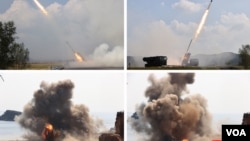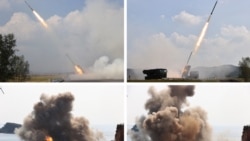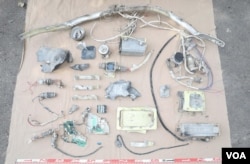미국의 전문가들은 기존 방사포에 유도 기능을 추가했다는 북한의 주장에 대해 아직은 신뢰하기 어렵다고 지적했습니다. 북한이 러시아로부터 관련 기술을 이전받고 생산기지 역할을 할 가능성이 있다는 분석도 제기됐습니다. 조상진 기자가 보도합니다.
로버트 피터스 헤리티지재단 핵억제 및 미사일 방어 연구원은 9일 VOA와의 전화통화에서 ‘240mm 방사포에 유도 역량을 확보했다’는 북한의 주장에 대해 “신뢰하기 어렵다”고 밝혔습니다.
[녹취: 피터스 연구원] “We can't give them too much credit on their ability to make stuff that's good. We're seeing dud rates of upwards of 50 percent in some of the shells that are being employed in Ukraine by the Russians. When they're firing North Korean artillery shells we're seeing a lot of artillery shells and there's some evidence of the Srbms short range ballistic missiles that the North Koreans have been given to the Russians simply not even launching. And so what you're getting is basically high rates of ineffectiveness. So oftentimes they don't fire and then half the times when they do fire, they don't actually have an explosive effect. And so the North Koreans may claim that these rocket systems are highly effective or that their accuracy because the guidance systems are very high but we need to take that with a great big grain assault. I simply don't see any evidence that the stuff that North Korea produces when it comes to missions or artillery rounds or short range ballistic missiles have anywhere near the level of accuracy or effectiveness that we have within the West or within Northeast Asia.”
로버트 피터스 연구원은 러시아가 우크라이나 전장에서 사용하고 있는 북한제 포탄의 절반 이상이 불발되고 있으며, 일부 단거리 탄도미사일은 발사 자체가 실패하는 사례들이 계속 보고 되고 있다고 지적했습니다.
또한 북한이 확증이 어려운 몇 장의 사진과 일방적 발표만으로 유도 체계 장착 성공과 정확성을 계속 주장하고 있는 점도 근거로 제시했습니다.
그러면서 “북한이 방사포나 단거리 탄도미사일 생산과 관련해 서방이나 동북아시아 지역 내 동맹들이 갖고 있는 수준의 정확성이나 효과에 근접한다는 어떤 증거도 보지 못했다”고 말했습니다.
아울러 북한이 유도 기능을 갖춘 방사포 포탄을 개발했다고 최초로 공개한 올해 2월 이래로 지금까지 두 차례나 더 추가 실험을 진행한 것은 아직 완전한 역량 확보에 이르지 못했다는 방증일 수 있다고 지적했습니다.
앞서 대외관영 ‘조선중앙통신’은 북한 국방과학원이 8일 제2경제위원회 산하 국방공업기업소에서 생산 중인 240mm 조종방사포탄의 검수시험사격을 진행했다고 보도했습니다.
이어 이번 검수시험사격의 목적은 자동사격체계의 신뢰도를 검증하고, 최대사거리 67km에 대한 조종방사포탄의 명중정확성을 재확인하는 것이라고 설명했습니다.
북한의 240mm 방사포는 한국 군의 전선부대와 수도권을 겨냥하는 장사정포에 해당하는 무기체계로, 240mm 조종방사포탄은 기존 240mm 방사포탄에 유도 기능을 추가한 ‘갱신형’ 무기입니다.
북한은 지난 2월 국방과학원이 유도 기능을 갖춘 240㎜ 방사포를 개발했다고 발표했고, 8월에는 갱신형 240mm 방사포무기체계 전반에 대한 검수시험사격을 진행했습니다.
“북한, 러 기술 이전 받고 생산기지 역할”
브루스 베넷 랜드연구소 선임연구원도 이날 VOA와의 전화통화에서 북한이 완전한 유도 기능을 확보했는지 정확히 알 수 없다는 데 동의했습니다.
베넷 선임연구원은 북한이 지난 8월 유도 체계의 우월성이 입증됐다고 주장하며 공개한 사진은 목표물을 조준하는 모습으로 타격이 성공했다는 증거가 될 수는 없다고 지적했습니다.
다만 북한이 중국과 러시아의 위성항법장치(GPS)에 접속할 수 있다는 이야기를 북한의 전직 고위 과학자로부터 전해 들었다면서, 그럴 경우 “방사포를 훨씬 더 정확하고 위협적으로 만드는 데 도움이 될 수 있다”고 말했습니다.
[녹취: 베넷 선임연구원] “Now my assumption there is that that GPS I've talked to a former North Korean senior scientists and they say that even 10 or 20 years ago North Korea had access to Chinese and Russian GPS. So certainly they could use Chinese and Russian GPS and that could make the, the 240 millimeter missiles much more accurate, much more of a threat. I think the technology likely came from Russia again, you know, the North Koreans want to use the Russian GPS. So I think the technology for these advances came from Russia. But think about it from Russia's perspective they've got all of their military plants cranking out at maximum to support the war in Ukraine and they're still not able to produce as much artillery and other things as they want and need for the war in Ukraine. Moreover, North Korea is a low cost production location. They can probably produce a multiple rocket launcher, rockets and launchers at a much lower cost than the Russian industry can produce. And so it kind of makes sense to give them the technology and then have them fill your needs.”
특히 북한은 현재 군사 분야 협력을 강화하고 있는 러시아로부터 관련 기술을 이전받고 GPS 사용을 허가받았을 가능성이 더 크다고 추정했습니다.
또한 러시아가 우크라이나 전쟁에 필요한 포탄과 다른 군수품 생산에 어려움을 겪고 있는 것도 이런 추정을 뒷받침한다고 말했습니다.
북한의 저렴한 노동력과 생산 비용을 고려할 때 러시아가 기술 이전을 조건으로 북한을 생산기지로 활용하려 할 수 있다는 설명입니다.
그러면서 러시아가 이란에 무인기 기술을 제공하고 이란이 다시 생산품을 러시아에 제공한 사례처럼 북한과 러시아도 상호 이익을 위해 그 같은 협력에 나설 가능성이 농후하다고 지적했습니다.
“한국 주요 시설, ‘표적 타격·초토화’ 가능”
베넷 선임연구원은 또 “북한이 기존 방사포 체계의 진전을 노리는 것이 매우 분명해 보인다”고 평가했습니다.
북한이 이미 한국을 겨냥해 사거리 약 60km의 초대형 방사포를 수백 문 이상 배치해 왔고 그 자체로 한국군과 수도권에 심각한 위협이 돼 왔는데, 여기에 유도 기능을 추가해 정확성을 높인다면 한국에 더 큰 추가적 위험을 가져올 수 있다고 말했습니다.
[녹취: 베넷 선임연구원] “So they could aim at say Incheon airport and put, you know, 240 millimeter rocket launcher has 22 rockets. They could put those rockets on specific parts of the maintenance areas at Incheon, on specific parts of the terminal and probably pretty well wipe out the buildings and that sort of thing at the airport. So it's not just that they would cause a lot of damage sort of all over the place they could hit very specific locations. We just saw that with the Iranian missile attack against Israel, they fired something like oh golly 80 rounds at one airfield and you know, the Israelis shot a bunch of them down but maybe 30 or 40 hit the airfield but they were sort of like a shotgun they were scattered and they didn't necessarily destroy meaningful buildings. That's what North Korea is trying to go beyond. They want to get specific targets. So if you fire, you know, think about it if I fire a shotgun as a shotgun and it scatters the pellets, the bullets all over the place, I'm going to hit some targets and I'm going to have a lot of my bullets missed targets. But if each one of those bullets is guided to a specific target, then I'm going to destroy specifically what I want to. I'm going to be far more efficient.”
베넷 선임연구원은 기존 방사포를 산탄총에 비유하면서, 정확성 보다는 특정 지역에 많은 화력을 집중시켜 위협을 가하는 무기라고 평가했습니다.
일례로 최근 이란이 이스라엘의 특정 비행 시설을 대상으로 대규모 미사일 공격을 가했지만, 산탄총처럼 흩어지면서 중요한 시설을 파괴하는 데 실패했다는 것입니다.
그러나 기존 방사포에 유도 체계가 성공적으로 도입되면 북한은 인천공항 등 한국의 주요 기간 시설을 거의 초토화할 수 있는 능력을 갖추게 될 것이라고 베넷 선임연구원은 말했습니다.
북한이 흔히 ‘서울 불바다’ 위협을 할 때마다 거론되는 북한 장사정포는 수도권을 사정거리에 두고 있는 170mm 자주포와 240mm 방사포 등 두 종류입니다.
240mm 방사포는 240mm 로켓 발사관이 12개 또는 22개 등 두 가지 형태가 있는데, 최대 사거리는 65~70km 정도로 알려져 있습니다.
로버트 피터스 연구원도 “북한이 240mm 방사포에 유도 체계를 장착하면 원형 오류 확률이 낮아져 훨씬 더 정확하게 목표를 타격할 수 있다”면서, 이를 통해 북한이 전장에서 실질적인 전술상 이점을 얻을 수 있다고 말했습니다.
그러면서 “개량 방사포는 북한이 한국 상공을 압도할 수 있는 역량을 제공함으로써 주한미군과 한국의 미사일 방어 효과를 무력화시키거나 완화하려는 시도”라고 평가했습니다.
“다른 미사일 체계와 조합 시 위협 배가”
샘 탕그레디 미 해군참모대학 미래전 연구소장도 북한이 광역 무기인 방사포에 유도 체계 도입으로 정밀도를 높이고, 이를 기존의 다른 무기체계와의 결합해 시너지 효과를 내려 한다고 진단했습니다.
샘 탕그레디
[탕그레디 교수] “I think it's clear that North Korea has made a strategic decision to lean really heavily into short range fires and that would be a combination of ballistic missiles, cruise missiles, drones, and heavy rocket artillery such as the 240 millimeter system. If the cheap cruise missiles with systems such as the large rocket systems and a lot of the drones that North Korea has been fielding, you can see how North Korea is trying to threaten South Korea's air defenses with different ranges, shell loads, and precision strike combinations.”
탕그레디 교수는 북한이 한국을 겨냥해 단거리 탄도미사일과 순항 미사일, 무인 공격기, 초대형 방사포와 같은 중화기 조합을 노리고 있다면서, 이를 통해 다양한 사거리 공격과 물량 공세, 정밀 타격을 통해 한국의 방공망을 위협하려 한다고 분석했습니다.
VOA 뉴스 조상진입니다.




















Forum